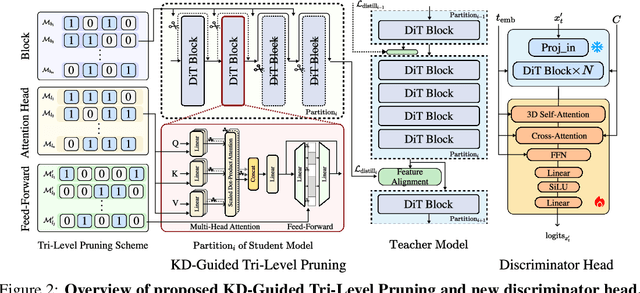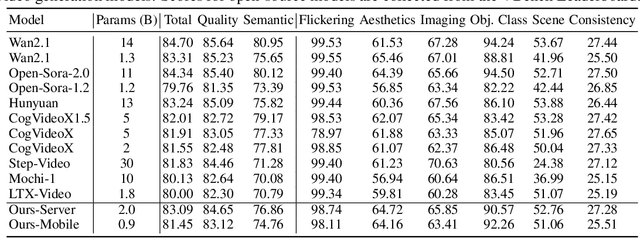Ke Ma
Stephen
TalkVerse: Democratizing Minute-Long Audio-Driven Video Generation
Dec 16, 2025Abstract:We introduce TalkVerse, a large-scale, open corpus for single-person, audio-driven talking video generation designed to enable fair, reproducible comparison across methods. While current state-of-the-art systems rely on closed data or compute-heavy models, TalkVerse offers 2.3 million high-resolution (720p/1080p) audio-video synchronized clips totaling 6.3k hours. These are curated from over 60k hours of video via a transparent pipeline that includes scene-cut detection, aesthetic assessment, strict audio-visual synchronization checks, and comprehensive annotations including 2D skeletons and structured visual/audio-style captions. Leveraging TalkVerse, we present a reproducible 5B DiT baseline built on Wan2.2-5B. By utilizing a video VAE with a high downsampling ratio and a sliding window mechanism with motion-frame context, our model achieves minute-long generation with low drift. It delivers comparable lip-sync and visual quality to the 14B Wan-S2V model but with 10$\times$ lower inference cost. To enhance storytelling in long videos, we integrate an MLLM director to rewrite prompts based on audio and visual cues. Furthermore, our model supports zero-shot video dubbing via controlled latent noise injection. We open-source the dataset, training recipes, and 5B checkpoints to lower barriers for research in audio-driven human video generation. Project Page: https://zhenzhiwang.github.io/talkverse/
DoGCLR: Dominance-Game Contrastive Learning Network for Skeleton-Based Action Recognition
Nov 19, 2025Abstract:Existing self-supervised contrastive learning methods for skeleton-based action recognition often process all skeleton regions uniformly, and adopt a first-in-first-out (FIFO) queue to store negative samples, which leads to motion information loss and non-optimal negative sample selection. To address these challenges, this paper proposes Dominance-Game Contrastive Learning network for skeleton-based action Recognition (DoGCLR), a self-supervised framework based on game theory. DoGCLR models the construction of positive and negative samples as a dynamic Dominance Game, where both sample types interact to reach an equilibrium that balances semantic preservation and discriminative strength. Specifically, a spatio-temporal dual weight localization mechanism identifies key motion regions and guides region-wise augmentations to enhance motion diversity while maintaining semantics. In parallel, an entropy-driven dominance strategy manages the memory bank by retaining high entropy (hard) negatives and replacing low-entropy (weak) ones, ensuring consistent exposure to informative contrastive signals. Extensive experiments are conducted on NTU RGB+D and PKU-MMD datasets. On NTU RGB+D 60 X-Sub/X-View, DoGCLR achieves 81.1%/89.4% accuracy, and on NTU RGB+D 120 X-Sub/X-Set, DoGCLR achieves 71.2%/75.5% accuracy, surpassing state-of-the-art methods by 0.1%, 2.7%, 1.1%, and 2.3%, respectively. On PKU-MMD Part I/Part II, DoGCLR performs comparably to the state-of-the-art methods and achieves a 1.9% higher accuracy on Part II, highlighting its strong robustness on more challenging scenarios.
PAVE: An End-to-End Dataset for Production Autonomous Vehicle Evaluation
Nov 19, 2025Abstract:Most existing autonomous-driving datasets (e.g., KITTI, nuScenes, and the Waymo Perception Dataset), collected by human-driving mode or unidentified driving mode, can only serve as early training for the perception and prediction of autonomous vehicles (AVs). To evaluate the real behavioral safety of AVs controlled in the black box, we present the first end-to-end benchmark dataset collected entirely by autonomous-driving mode in the real world. This dataset contains over 100 hours of naturalistic data from multiple production autonomous-driving vehicle models in the market. We segment the original data into 32,727 key frames, each consisting of four synchronized camera images and high-precision GNSS/IMU data (0.8 cm localization accuracy). For each key frame, 20 Hz vehicle trajectories spanning the past 6 s and future 5 s are provided, along with detailed 2D annotations of surrounding vehicles, pedestrians, traffic lights, and traffic signs. These key frames have rich scenario-level attributes, including driver intent, area type (covering highways, urban roads, and residential areas), lighting (day, night, or dusk), weather (clear or rain), road surface (paved or unpaved), traffic and vulnerable road users (VRU) density, traffic lights, and traffic signs (warning, prohibition, and indication). To evaluate the safety of AVs, we employ an end-to-end motion planning model that predicts vehicle trajectories with an Average Displacement Error (ADE) of 1.4 m on autonomous-driving frames. The dataset continues to expand by over 10 hours of new data weekly, thereby providing a sustainable foundation for research on AV driving behavior analysis and safety evaluation. The PAVE dataset is publicly available at https://hkustgz-my.sharepoint.com/:f:/g/personal/kema_hkust-gz_edu_cn/IgDXyoHKfdGnSZ3JbbidjduMAXxs-Z3NXzm005A_Ix9tr0Q?e=9HReCu.
Phys-Liquid: A Physics-Informed Dataset for Estimating 3D Geometry and Volume of Transparent Deformable Liquids
Nov 14, 2025



Abstract:Estimating the geometric and volumetric properties of transparent deformable liquids is challenging due to optical complexities and dynamic surface deformations induced by container movements. Autonomous robots performing precise liquid manipulation tasks, such as dispensing, aspiration, and mixing, must handle containers in ways that inevitably induce these deformations, complicating accurate liquid state assessment. Current datasets lack comprehensive physics-informed simulation data representing realistic liquid behaviors under diverse dynamic scenarios. To bridge this gap, we introduce Phys-Liquid, a physics-informed dataset comprising 97,200 simulation images and corresponding 3D meshes, capturing liquid dynamics across multiple laboratory scenes, lighting conditions, liquid colors, and container rotations. To validate the realism and effectiveness of Phys-Liquid, we propose a four-stage reconstruction and estimation pipeline involving liquid segmentation, multi-view mask generation, 3D mesh reconstruction, and real-world scaling. Experimental results demonstrate improved accuracy and consistency in reconstructing liquid geometry and volume, outperforming existing benchmarks. The dataset and associated validation methods facilitate future advancements in transparent liquid perception tasks. The dataset and code are available at https://dualtransparency.github.io/Phys-Liquid/.
Learn Faster and Remember More: Balancing Exploration and Exploitation for Continual Test-time Adaptation
Aug 18, 2025Abstract:Continual Test-Time Adaptation (CTTA) aims to adapt a source pre-trained model to continually changing target domains during inference. As a fundamental principle, an ideal CTTA method should rapidly adapt to new domains (exploration) while retaining and exploiting knowledge from previously encountered domains to handle similar domains in the future. Despite significant advances, balancing exploration and exploitation in CTTA is still challenging: 1) Existing methods focus on adjusting predictions based on deep-layer outputs of neural networks. However, domain shifts typically affect shallow features, which are inefficient to be adjusted from deep predictions, leading to dilatory exploration; 2) A single model inevitably forgets knowledge of previous domains during the exploration, making it incapable of exploiting historical knowledge to handle similar future domains. To address these challenges, this paper proposes a mean teacher framework that strikes an appropriate Balance between Exploration and Exploitation (BEE) during the CTTA process. For the former challenge, we introduce a Multi-level Consistency Regularization (MCR) loss that aligns the intermediate features of the student and teacher models, accelerating adaptation to the current domain. For the latter challenge, we employ a Complementary Anchor Replay (CAR) mechanism to reuse historical checkpoints (anchors), recovering complementary knowledge for diverse domains. Experiments show that our method significantly outperforms state-of-the-art methods on several benchmarks, demonstrating its effectiveness for CTTA tasks.
Architectural Co-Design for Zero-Shot Anomaly Detection: Decoupling Representation and Dynamically Fusing Features in CLIP
Aug 11, 2025Abstract:Pre-trained Vision-Language Models (VLMs) face a significant adaptation gap when applied to Zero-Shot Anomaly Detection (ZSAD), stemming from their lack of local inductive biases for dense prediction and their reliance on inflexible feature fusion paradigms. We address these limitations through an Architectural Co-Design framework that jointly refines feature representation and cross-modal fusion. Our method integrates a parameter-efficient Convolutional Low-Rank Adaptation (Conv-LoRA) adapter to inject local inductive biases for fine-grained representation, and introduces a Dynamic Fusion Gateway (DFG) that leverages visual context to adaptively modulate text prompts, enabling a powerful bidirectional fusion. Extensive experiments on diverse industrial and medical benchmarks demonstrate superior accuracy and robustness, validating that this synergistic co-design is critical for robustly adapting foundation models to dense perception tasks.
Taming Diffusion Transformer for Real-Time Mobile Video Generation
Jul 17, 2025



Abstract:Diffusion Transformers (DiT) have shown strong performance in video generation tasks, but their high computational cost makes them impractical for resource-constrained devices like smartphones, and real-time generation is even more challenging. In this work, we propose a series of novel optimizations to significantly accelerate video generation and enable real-time performance on mobile platforms. First, we employ a highly compressed variational autoencoder (VAE) to reduce the dimensionality of the input data without sacrificing visual quality. Second, we introduce a KD-guided, sensitivity-aware tri-level pruning strategy to shrink the model size to suit mobile platform while preserving critical performance characteristics. Third, we develop an adversarial step distillation technique tailored for DiT, which allows us to reduce the number of inference steps to four. Combined, these optimizations enable our model to achieve over 10 frames per second (FPS) generation on an iPhone 16 Pro Max, demonstrating the feasibility of real-time, high-quality video generation on mobile devices.
LidarPainter: One-Step Away From Any Lidar View To Novel Guidance
Jul 16, 2025Abstract:Dynamic driving scene reconstruction is of great importance in fields like digital twin system and autonomous driving simulation. However, unacceptable degradation occurs when the view deviates from the input trajectory, leading to corrupted background and vehicle models. To improve reconstruction quality on novel trajectory, existing methods are subject to various limitations including inconsistency, deformation, and time consumption. This paper proposes LidarPainter, a one-step diffusion model that recovers consistent driving views from sparse LiDAR condition and artifact-corrupted renderings in real-time, enabling high-fidelity lane shifts in driving scene reconstruction. Extensive experiments show that LidarPainter outperforms state-of-the-art methods in speed, quality and resource efficiency, specifically 7 x faster than StreetCrafter with only one fifth of GPU memory required. LidarPainter also supports stylized generation using text prompts such as "foggy" and "night", allowing for a diverse expansion of the existing asset library.
Pushing the Limits of Safety: A Technical Report on the ATLAS Challenge 2025
Jun 14, 2025Abstract:Multimodal Large Language Models (MLLMs) have enabled transformative advancements across diverse applications but remain susceptible to safety threats, especially jailbreak attacks that induce harmful outputs. To systematically evaluate and improve their safety, we organized the Adversarial Testing & Large-model Alignment Safety Grand Challenge (ATLAS) 2025}. This technical report presents findings from the competition, which involved 86 teams testing MLLM vulnerabilities via adversarial image-text attacks in two phases: white-box and black-box evaluations. The competition results highlight ongoing challenges in securing MLLMs and provide valuable guidance for developing stronger defense mechanisms. The challenge establishes new benchmarks for MLLM safety evaluation and lays groundwork for advancing safer multimodal AI systems. The code and data for this challenge are openly available at https://github.com/NY1024/ATLAS_Challenge_2025.
Adapt Once, Thrive with Updates: Transferable Parameter-Efficient Fine-Tuning on Evolving Base Models
Jun 07, 2025Abstract:Parameter-efficient fine-tuning (PEFT) has become a common method for fine-tuning large language models, where a base model can serve multiple users through PEFT module switching. To enhance user experience, base models require periodic updates. However, once updated, PEFT modules fine-tuned on previous versions often suffer substantial performance degradation on newer versions. Re-tuning these numerous modules to restore performance would incur significant computational costs. Through a comprehensive analysis of the changes that occur during base model updates, we uncover an interesting phenomenon: continual training primarily affects task-specific knowledge stored in Feed-Forward Networks (FFN), while having less impact on the task-specific pattern in the Attention mechanism. Based on these findings, we introduce Trans-PEFT, a novel approach that enhances the PEFT module by focusing on the task-specific pattern while reducing its dependence on certain knowledge in the base model. Further theoretical analysis supports our approach. Extensive experiments across 7 base models and 12 datasets demonstrate that Trans-PEFT trained modules can maintain performance on updated base models without re-tuning, significantly reducing maintenance overhead in real-world applications.
 Add to Chrome
Add to Chrome Add to Firefox
Add to Firefox Add to Edge
Add to Edge